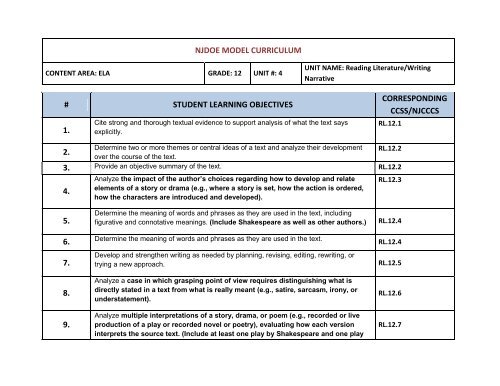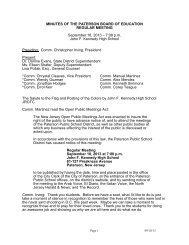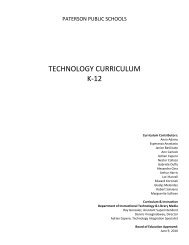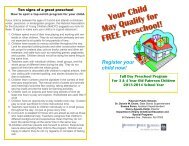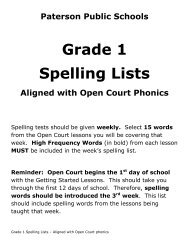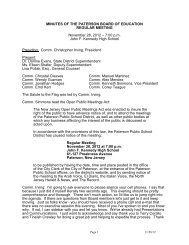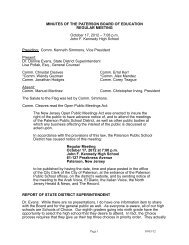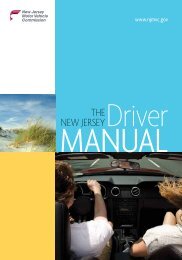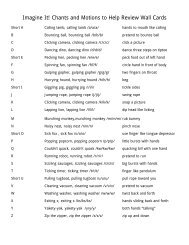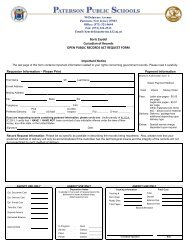Grade 12 Unit 4
Grade 12 Unit 4
Grade 12 Unit 4
Create successful ePaper yourself
Turn your PDF publications into a flip-book with our unique Google optimized e-Paper software.
NJDOE MODEL CURRICULUM<br />
CONTENT AREA: ELA GRADE: <strong>12</strong> UNIT #: 4<br />
UNIT NAME: Reading Literature/Writing<br />
Narrative<br />
# STUDENT LEARNING OBJECTIVES<br />
1.<br />
Cite strong and thorough textual evidence to support analysis of what the text says<br />
explicitly.<br />
CORRESPONDING<br />
CCSS/NJCCCS<br />
RL.<strong>12</strong>.1<br />
Determine two or more themes or central ideas of a text and analyze their development RL.<strong>12</strong>.2<br />
2.<br />
over the course of the text.<br />
3. Provide an objective summary of the text. RL.<strong>12</strong>.2<br />
Analyze the impact of the author’s choices regarding how to develop and relate RL.<strong>12</strong>.3<br />
elements of a story or drama (e.g., where a story is set, how the action is ordered,<br />
4.<br />
how the characters are introduced and developed).<br />
5.<br />
Determine the meaning of words and phrases as they are used in the text, including<br />
figurative and connotative meanings. (Include Shakespeare as well as other authors.)<br />
RL.<strong>12</strong>.4<br />
6.<br />
Determine the meaning of words and phrases as they are used in the text.<br />
7.<br />
Develop and strengthen writing as needed by planning, revising, editing, rewriting, or<br />
trying a new approach.<br />
RL.<strong>12</strong>.4<br />
RL.<strong>12</strong>.5<br />
8.<br />
9.<br />
Analyze a case in which grasping point of view requires distinguishing what is<br />
directly stated in a text from what is really meant (e.g., satire, sarcasm, irony, or<br />
understatement).<br />
Analyze multiple interpretations of a story, drama, or poem (e.g., recorded or live<br />
production of a play or recorded novel or poetry), evaluating how each version<br />
interprets the source text. (Include at least one play by Shakespeare and one play<br />
RL.<strong>12</strong>.6<br />
RL.<strong>12</strong>.7
NJDOE MODEL CURRICULUM<br />
CONTENT AREA: ELA GRADE: <strong>12</strong> UNIT #: 4<br />
UNIT NAME: Reading Literature/Writing<br />
Narrative<br />
10.<br />
11.<br />
<strong>12</strong>.<br />
13.<br />
14.<br />
15.<br />
16.<br />
by an American dramatist.)<br />
Demonstrate knowledge of eighteenth-, nineteenth- and early-twentieth-century<br />
foundational works of American literature, including how two or more texts from<br />
the same period treat similar themes or topics.<br />
By the end of grade <strong>12</strong>, read and comprehend literature, including stories, dramas, and<br />
poems, in the grades 11-<strong>12</strong>–CCR text complexity band proficiently, with scaffolding as<br />
needed at the high end of the range.<br />
Write narratives to develop real or imagined experiences or events using effective<br />
technique, well-chosen details, and well-structured event sequences.<br />
When writing narratives, engage and orient the reader by setting out a problem, situation,<br />
or observation and its significance, establishing one or multiple point(s) of view, and<br />
introducing a narrator and/or characters.<br />
When writing narratives, create a smooth progression of experiences or events.<br />
When writing narratives, use narrative techniques, such as dialogue, pacing, description,<br />
reflection, and multiple plot lines, to develop experiences, events, and/or characters.<br />
When writing narratives, use a variety of techniques to sequence events so that they build<br />
on one another to create a coherent whole and build toward a particular tone and<br />
outcome (e.g., a sense of mystery, suspense, growth, or resolution).<br />
RL.<strong>12</strong>.9<br />
RL.<strong>12</strong>.10<br />
W.<strong>12</strong>.3<br />
W.<strong>12</strong>.3a.<br />
W.<strong>12</strong>.3a.<br />
W.<strong>12</strong>.3b.<br />
W.<strong>12</strong>.3c.<br />
17. When writing narratives, use precise words and phrases, telling details, and sensory W.<strong>12</strong>.3d.
NJDOE MODEL CURRICULUM<br />
CONTENT AREA: ELA GRADE: <strong>12</strong> UNIT #: 4<br />
UNIT NAME: Reading Literature/Writing<br />
Narrative<br />
language to convey a vivid picture of the experiences, events, setting, and/or characters.<br />
18. When writing narratives, provide a conclusion that follows from and reflects on what is<br />
experienced, observed, or resolved over the course of the narrative.<br />
W.<strong>12</strong>.3e.<br />
19.<br />
20.<br />
21.<br />
22.<br />
23.<br />
24.<br />
Produce clear and coherent writing in which the development, organization, and style are<br />
appropriate to task, purpose, and audience.<br />
Develop and strengthen writing as needed by planning, revising, editing, rewriting, or<br />
trying a new approach, focusing on addressing what is most significant for a specific<br />
purpose and audience.<br />
Use technology, including the Internet, to produce, publish, and update individual or<br />
shared writing products.<br />
Conduct short as well as more sustained research projects to answer a question<br />
(including a self-generated question) or solve a problem; narrow or broaden the inquiry<br />
when appropriate; synthesize multiple sources on the subject, demonstrating<br />
understanding of the subject under investigation.<br />
Draw evidence from literary texts to support analysis, reflection, and research; apply<br />
grade <strong>12</strong> Reading standards to literature (e.g., “Demonstrate knowledge of<br />
eighteenth-, nineteenth- and early-twentieth-century foundational works of<br />
American literature, including how two or more texts from the same period treat<br />
similar themes or topics”).<br />
Write routinely over extended time frames (time for research, reflection, and revision) and<br />
shorter time frames (a single sitting or a day or two) for a range of tasks, purposes, and<br />
W.<strong>12</strong>.4<br />
W.<strong>12</strong>.5<br />
W.<strong>12</strong>.6<br />
W.<strong>12</strong>.7<br />
W.<strong>12</strong>.9a.<br />
W.<strong>12</strong>.10
NJDOE MODEL CURRICULUM<br />
CONTENT AREA: ELA GRADE: <strong>12</strong> UNIT #: 4<br />
UNIT NAME: Reading Literature/Writing<br />
Narrative<br />
25.<br />
audiences.<br />
Initiate and participate effectively in a range of collaborative discussions (one-on-one, in<br />
groups, and teacher-led) with diverse partners on grade <strong>12</strong> topics, texts, and issues,<br />
building on others’ ideas and expressing their own clearly and persuasively.<br />
SL.<strong>12</strong>.1<br />
26.<br />
Come to discussions prepared, having read and researched material under study.<br />
27.<br />
Explicitly refer to evidence from texts and other research on the topic or issue to stimulate<br />
a thoughtful, well- reasoned exchange of ideas.<br />
SL.<strong>12</strong>.1a.<br />
SL.<strong>12</strong>.1a.<br />
28.<br />
29.<br />
30.<br />
31.<br />
Work with peers to promote civil, democratic discussions and decision making, set<br />
clear goals and deadlines, and establish individual roles as needed.<br />
Propel conversations by posing and responding to questions that probe reasoning and<br />
evidence; ensure a hearing for a full range of positions on a topic or issue; clarify,<br />
verify, or challenge ideas and conclusions; and promote divergent and creative<br />
perspectives.<br />
Respond thoughtfully to diverse perspectives; synthesize comments, claims, and<br />
evidence made on all sides of an issue; resolve contradictions when possible; and<br />
determine what additional information or research is required to deepen the<br />
investigation or complete the task.<br />
Integrate multiple sources of information presented in diverse formats and media (e.g.,<br />
visually, quantitatively, orally) in order to make informed decisions and solve<br />
problems, evaluating the credibility and accuracy of each source and noting any<br />
SL.<strong>12</strong>.1b.<br />
SL.<strong>12</strong>.1c.<br />
SL.<strong>12</strong>.1d.<br />
SL.<strong>12</strong>.2
NJDOE MODEL CURRICULUM<br />
CONTENT AREA: ELA GRADE: <strong>12</strong> UNIT #: 4<br />
UNIT NAME: Reading Literature/Writing<br />
Narrative<br />
32.<br />
33.<br />
34.<br />
35.<br />
36.<br />
37.<br />
discrepancies among the data.<br />
Evaluate a speaker’s point of view, reasoning, and use of evidence and rhetoric,<br />
assessing the stance, premises, links among ideas, word choice, points of<br />
emphasis, and tone used.<br />
Present information, findings, and supporting evidence, conveying a clear and distinct<br />
perspective, such that listeners can follow the line of reasoning, alternative or opposing<br />
perspectives are addressed, and the organization, development, substance, and style<br />
are appropriate to purpose, audience, and a range of formal and informal tasks.<br />
Make strategic use of digital media (e.g., textual, graphical, audio, visual, and interactive<br />
elements) in presentations to enhance understanding of findings, reasoning, and evidence<br />
and to add interest.<br />
Adapt speech to a variety of contexts and tasks, demonstrating a command of formal<br />
English when indicated or appropriate.<br />
Demonstrate command of the conventions of standard English grammar and usage when<br />
writing or speaking; apply the understanding that usage is a matter of convention,<br />
can change over time, and is sometimes contested.<br />
Resolve issues of complex or contested usage, consulting references (e.g.,<br />
Merriam-Webster’s Dictionary of English Usage, Garner’s Modern American Usage)<br />
as needed.<br />
SL.<strong>12</strong>.3<br />
SL.<strong>12</strong>.4<br />
SL.<strong>12</strong>.5<br />
SL.<strong>12</strong>.6<br />
L.<strong>12</strong>.1; L.<strong>12</strong>.1a.<br />
L.<strong>12</strong>.1b.<br />
38. Demonstrate command of the conventions of standard English capitalization, punctuation, L.<strong>12</strong>.2; L.<strong>12</strong>.2a.
NJDOE MODEL CURRICULUM<br />
CONTENT AREA: ELA GRADE: <strong>12</strong> UNIT #: 4<br />
UNIT NAME: Reading Literature/Writing<br />
Narrative<br />
and spelling when writing; observe hyphenation conventions when writing.<br />
39.<br />
Spell correctly when writing narratives.<br />
40.<br />
Apply knowledge of language to understand how language functions in different contexts,<br />
to make effective choices for meaning or style, and to comprehend more fully when<br />
reading or listening.<br />
L.<strong>12</strong>.2b.<br />
L.<strong>12</strong>.3<br />
41.<br />
42.<br />
43.<br />
44.<br />
45.<br />
46.<br />
Vary syntax for effect, consulting references (e.g., Tufte’s Artful Sentences) for<br />
guidance as needed.<br />
Determine or clarify the meaning of unknown and multiple-meaning words and phrases<br />
based on grade <strong>12</strong> reading and content, choosing flexibly from a range of strategies.<br />
Use context (e.g., the overall meaning of a sentence, paragraph, or text; a word’s position<br />
or function in a sentence) as a clue to the meaning of a word or phrase<br />
Identify and correctly use patterns of word changes that indicate different meanings or<br />
parts of speech (e.g., conceive, conception, conceivable) when writing and speaking.<br />
Acquire and use accurately general academic and domain-specific words and phrases,<br />
sufficient for reading, writing, speaking, and listening at the college and career readiness<br />
level; demonstrate independence in gathering vocabulary knowledge when considering a<br />
word or phrase important to comprehension or expression.<br />
Demonstrate understanding of figurative language; interpret figures of speech (e.g.,<br />
hyperbole, paradox) in context and analyze their role in the text when writing and<br />
L.<strong>12</strong>.3a.<br />
L.<strong>12</strong>.4<br />
L.<strong>12</strong>.4a.<br />
L.<strong>12</strong>.4b.<br />
L.<strong>12</strong>.4c.d.<br />
L.<strong>12</strong>.5a
NJDOE MODEL CURRICULUM<br />
CONTENT AREA: ELA GRADE: <strong>12</strong> UNIT #: 4<br />
UNIT NAME: Reading Literature/Writing<br />
Narrative<br />
47.<br />
48.<br />
49.<br />
speaking.<br />
Demonstrate understanding word relationships, and nuances in word meanings; analyze<br />
nuances in the meaning of words with similar denotations.<br />
Acquire and use accurately general academic and domain-specific words and phrases,<br />
sufficient for reading, writing, speaking, and listening at the college and career readiness<br />
level.<br />
Demonstrate independence in gathering vocabulary knowledge when considering a word<br />
or phrase important to comprehension or expression.<br />
L.<strong>12</strong>.5b.<br />
L.<strong>12</strong>.6<br />
L.<strong>12</strong>.6<br />
Code #<br />
Common Core State Standards<br />
RL.<strong>12</strong>.1<br />
RL.<strong>12</strong>.2<br />
RL.<strong>12</strong>.3<br />
RL.<strong>12</strong>.4<br />
Cite strong and thorough textual evidence to support analysis of what the text says explicitly as well as inferences<br />
drawn from the text, including determining where the text leaves matters uncertain.<br />
Determine two or more themes or central ideas of a text and analyze their development over the course of the text,<br />
including how they interact and build on one another to produce a complex account; provide an objective<br />
summary of the text.<br />
Analyze the impact of the author’s choices regarding how to develop and relate elements of a story or<br />
drama (e.g., where a story is set, how the action is ordered, how the characters are introduced and<br />
developed).<br />
Determine the meaning of words and phrases as they are used in the text, including figurative and connotative
NJDOE MODEL CURRICULUM<br />
CONTENT AREA: ELA GRADE: <strong>12</strong> UNIT #: 4<br />
UNIT NAME: Reading Literature/Writing<br />
Narrative<br />
meanings; analyze the impact of specific word choices on meaning and tone, including words with multiple<br />
meanings or language that is particularly fresh, engaging, or beautiful. (Include Shakespeare as well as<br />
other authors.)<br />
RL.<strong>12</strong>.5<br />
RL.<strong>12</strong>.6<br />
RL.<strong>12</strong>.7<br />
RL.<strong>12</strong>.9<br />
Analyze how an author’s choices concerning how to structure specific parts of a text (e.g., the choice of where<br />
to begin or end a story, the choice to provide a comedic or tragic resolution) contribute to its overall<br />
structure and meaning as well as its aesthetic impact.<br />
Analyze a case in which grasping point of view requires distinguishing what is directly stated in a text from<br />
what is really meant (e.g., satire, sarcasm, irony, or understatement).<br />
Analyze multiple interpretations of a story, drama, or poem (e.g., recorded or live production of a play or<br />
recorded novel or poetry), evaluating how each version interprets the source text. (Include at least one play<br />
by Shakespeare and one play by an American dramatist.)<br />
Demonstrate knowledge of eighteenth-, nineteenth- and early-twentieth-century foundational works of<br />
American literature, including how two or more texts from the same period treat similar themes or topics.<br />
RL.<strong>12</strong>.10 By the end of grade <strong>12</strong>, read and comprehend literature, including stories, dramas, and poems, in the grades 11–<br />
CCR text complexity band proficiently, with scaffolding as needed at the high end of the range.<br />
W.<strong>12</strong>.3<br />
Write narratives to develop real or imagined experiences or events using effective technique, well-chosen details,<br />
and well-structured event sequences.<br />
a. Engage and orient the reader by setting out a problem, situation, or observation and its significance,<br />
establishing one or multiple point(s) of view, and introducing a narrator and/or characters; create a smooth<br />
progression of experiences or events.<br />
b. Use narrative techniques, such as dialogue, pacing, description, reflection, and multiple plot lines, to develop
NJDOE MODEL CURRICULUM<br />
CONTENT AREA: ELA GRADE: <strong>12</strong> UNIT #: 4<br />
UNIT NAME: Reading Literature/Writing<br />
Narrative<br />
experiences, events, and/or characters.<br />
c. Use a variety of techniques to sequence events so that they build on one another to create a coherent whole and<br />
build toward a particular tone and outcome (e.g., a sense of mystery, suspense, growth, or resolution).<br />
d. Use precise words and phrases, telling details, and sensory language to convey a vivid picture of the<br />
experiences, events, setting, and/or characters.<br />
e. Provide a conclusion that follows from and reflects on what is experienced, observed, or resolved over the course<br />
of the narrative.<br />
W.<strong>12</strong>.4<br />
W.<strong>12</strong>.5<br />
W.<strong>12</strong>.6<br />
W.<strong>12</strong>.7<br />
W.<strong>12</strong>.9a.<br />
Produce clear and coherent writing in which the development, organization, and style are appropriate to task,<br />
purpose, and audience. (<strong>Grade</strong>-specific expectations for writing types are defined in standards 1–3 above.)<br />
Develop and strengthen writing as needed by planning, revising, editing, rewriting, or trying a new approach,<br />
focusing on addressing what is most significant for a specific purpose and audience.<br />
Use technology, including the Internet, to produce, publish, and update individual or shared writing products in<br />
response to ongoing feedback, including new arguments or information.<br />
Conduct short as well as more sustained research projects to answer a question (including a self-generated<br />
question) or solve a problem; narrow or broaden the inquiry when appropriate; synthesize multiple sources on the<br />
subject, demonstrating understanding of the subject under investigation.<br />
Draw evidence from literary or informational texts to support analysis, reflection, and research.<br />
a. Apply grade <strong>12</strong> Reading standards to literature (e.g., “Demonstrate knowledge of eighteenth-, nineteenthand<br />
early-twentieth-century foundational works of American literature, including how two or more texts
NJDOE MODEL CURRICULUM<br />
CONTENT AREA: ELA GRADE: <strong>12</strong> UNIT #: 4<br />
UNIT NAME: Reading Literature/Writing<br />
Narrative<br />
from the same period treat similar themes or topics”).<br />
W.<strong>12</strong>.10 Write routinely over extended time frames (time for research, reflection, and revision) and shorter time frames (a<br />
single sitting or a day or two) for a range of tasks, purposes, and audiences.<br />
SL.<strong>12</strong>.1<br />
Initiate and participate effectively in a range of collaborative discussions (one-on-one, in groups, and teacher-led)<br />
with diverse partners on grade 11 topics, texts, and issues, building on others’ ideas and expressing their own<br />
clearly and persuasively.<br />
a. Come to discussions prepared, having read and researched material under study; explicitly draw on that<br />
preparation by referring to evidence from texts and other research on the topic or issue to stimulate a thoughtful,<br />
well- reasoned exchange of ideas.<br />
b. Work with peers to promote civil, democratic discussions and decision making, set clear goals and<br />
deadlines, and establish individual roles as needed.<br />
c. Propel conversations by posing and responding to questions that probe reasoning and evidence; ensure a<br />
hearing for a full range of positions on a topic or issue; clarify, verify, or challenge ideas and conclusions; and<br />
promote divergent and creative perspectives.<br />
d. Respond thoughtfully to diverse perspectives; synthesize comments, claims, and evidence made on all sides<br />
of an issue; resolve contradictions when possible; and determine what additional information or research is<br />
required to deepen the investigation or complete the task.<br />
SL.<strong>12</strong>.2<br />
Integrate multiple sources of information presented in diverse formats and media (e.g., visually, quantitatively,<br />
orally) in order to make informed decisions and solve problems, evaluating the credibility and accuracy of each<br />
source and noting any discrepancies among the data.
NJDOE MODEL CURRICULUM<br />
CONTENT AREA: ELA GRADE: <strong>12</strong> UNIT #: 4<br />
UNIT NAME: Reading Literature/Writing<br />
Narrative<br />
SL.<strong>12</strong>.3<br />
SL.<strong>12</strong>.4<br />
SL.<strong>12</strong>.5<br />
SL.<strong>12</strong>.6<br />
L.<strong>12</strong>.1<br />
Evaluate a speaker’s point of view, reasoning, and use of evidence and rhetoric, assessing the stance, premises,<br />
links among ideas, word choice, points of emphasis, and tone used.<br />
Present information, findings, and supporting evidence, conveying a clear and distinct perspective, such that<br />
listeners can follow the line of reasoning, alternative or opposing perspectives are addressed, and the<br />
organization, development, substance, and style are appropriate to purpose, audience, and a range of formal and<br />
informal tasks.<br />
Make strategic use of digital media (e.g., textual, graphical, audio, visual, and interactive elements) in<br />
presentations to enhance understanding of findings, reasoning, and evidence and to add interest.<br />
Adapt speech to a variety of contexts and tasks, demonstrating a command of formal English when indicated or<br />
appropriate.<br />
Demonstrate command of the conventions of standard English grammar and usage when writing or speaking.<br />
a. Apply the understanding that usage is a matter of convention, can change over time, and is sometimes<br />
contested.<br />
b. Resolve issues of complex or contested usage, consulting references (e.g., Merriam-Webster’s Dictionary<br />
of English Usage, Garner’s Modern American Usage) as needed.<br />
L.<strong>12</strong>.2<br />
Demonstrate command of the conventions of standard English capitalization, punctuation, and spelling when<br />
writing.<br />
a. Observe hyphenation conventions.<br />
b. Spell correctly.
NJDOE MODEL CURRICULUM<br />
CONTENT AREA: ELA GRADE: <strong>12</strong> UNIT #: 4<br />
UNIT NAME: Reading Literature/Writing<br />
Narrative<br />
L.<strong>12</strong>.3<br />
Apply knowledge of language to understand how language functions in different contexts, to make effective choices<br />
for meaning or style, and to comprehend more fully when reading or listening.<br />
a. Vary syntax for effect, consulting references (e.g., Tufte’s Artful Sentences) for guidance as needed;<br />
apply an understanding of syntax to the study of complex texts when reading.<br />
L.<strong>12</strong>.4<br />
Determine or clarify the meaning of unknown and multiple-meaning words and phrases based on grade 11 reading<br />
and content, choosing flexibly from a range of strategies.<br />
a. Use context (e.g., the overall meaning of a sentence, paragraph, or text; a word’s position or function in a<br />
sentence) as a clue to the meaning of a word or phrase.<br />
b. Identify and correctly use patterns of word changes that indicate different meanings or parts of speech (e.g.,<br />
conceive, conception, conceivable).<br />
c. Consult general and specialized reference materials (e.g., dictionaries, glossaries, thesauruses), both print and<br />
digital, to find the pronunciation of a word or determine or clarify its precise meaning, its part of speech, its<br />
etymology, or its standard usage.<br />
d. Verify the preliminary determination of the meaning of a word or phrase (e.g., by checking the inferred meaning in<br />
context or in a dictionary)<br />
L.<strong>12</strong>.5<br />
Demonstrate understanding of figurative language, word relationships, and nuances in word meanings.<br />
a. Interpret figures of speech (e.g., hyperbole, paradox) in context and analyze their role in the text.<br />
b. Analyze nuances in the meaning of words with similar denotations.<br />
L.<strong>12</strong>.6<br />
Acquire and use accurately general academic and domain-specific words and phrases, sufficient for reading,
NJDOE MODEL CURRICULUM<br />
CONTENT AREA: ELA GRADE: <strong>12</strong> UNIT #: 4<br />
UNIT NAME: Reading Literature/Writing<br />
Narrative<br />
writing, speaking, and listening at the college and career readiness level; demonstrate independence in gathering<br />
vocabulary knowledge when considering a word or phrase important to comprehension or expression.


